Sorry to burst your bubble
Chazot Thoughts
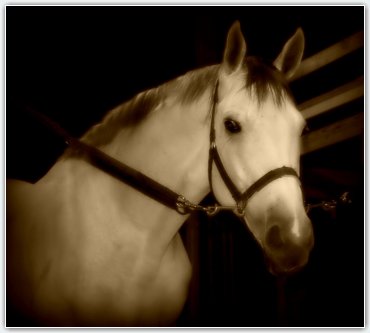
Thoughts
XI
(Sorry to burst your bubble but that is not piaff)
Often at the end of the day, Helyn and he bring out two chairs and drinks and sit between Manchester’s pasture and my turn out and watch us. This is a time of peace where we all enjoy each other’s company. Even the kissing machine is resting. Bretelle is a boxer with a tongue longer than his body. He is the gentlest dog on earth but he always tries to kiss us. You cannot imagine the length of his tongue. I lift my nose a few inches thinking that I am out of reach and within the next second I have half of his tongue deep inside my nostril.
Sometimes, Helyn and he are engaged in a long conversation. Other times they stay silent listening and watching. Yesterday, Helyn brought a photo that she took earlier during our training session. She walked toward me showing the picture. I remember the trot departure. I felt I was in good balance and succeeded in a departure quite collected. 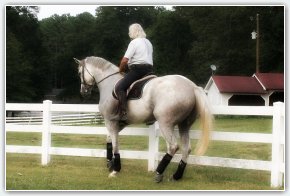 I noticed the position of my legs on the picture thinking that it almost looks like piaff. This is when he thinks, Sorry to burst your bubble but that is not piaff.
I noticed the position of my legs on the picture thinking that it almost looks like piaff. This is when he thinks, Sorry to burst your bubble but that is not piaff.
I was shocked. I am supposed to be the one who can read his thoughts. He is not supposed to know mine. I knew that this was not piaff. I was simply playing the game of many riders who are using pictures, which look like piaff to burst their ego. Mostly to verify if he really can read my thoughts I pushed the issue insisting that may be it was not a true piaff but it was close. He scared me, as he thought, “Not even close. The picture was taken at a good time and your legs may appear to be doing piaff but the synchronization of your back and legs is not correct. Your supporting hind leg is on the pushing phase. If you were at the piaff, it would be in the braking phase. I said to Manchester, he really knows what I think. Manchester disagreed. I don’t think so. He does not even believe in animal communicators. Your former owner was a so-called animal communicator and she never had any clue of your emotions, suffering and thinking. Let me tell you what I think is happening. My belief is that when his brain is on a subject, he explores further and further. I think that he is following his own thoughts and it just happens that his thoughts appear to answer your questions. In fact; I see there the potential for some juicy exchanges. Ask him about subjects unrelated to horses.
I asked then, what do you think about the catwalk of fashion show models. His thought was, bad judges can only see the legs action. They cannot see higher. They do not understand the biomechanics of the vertebral column. Manchester and I smiled thinking this one was not too bad. As he was thinking about the riders during piaff, I asked, what do you think about the members of congress? “They shake their butt back and forth to keep the momentum going. If they were using their brains instead, the performances would be much better.” Manchester and I were now laughing. This one was not bad at all. He was thinking about training techniques activating the horses’ hind legs with a dressage whip and I asked, what about the tea party? “You can brandish a long whip as much as you want, this does not awaken a dead brain.” Manchester was ecstatic. Then I asked, what about the horse whisperers? “It is always the ones who are doing the worse things behind the curtain that are presenting themselves as sweet and compassionate.” Manchester and I decided that this one was not humoristic but dead accurate. I tried French politics. 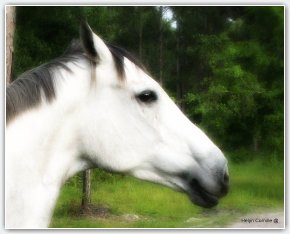 What do you think about the wife of the French president? “Beautiful.” I froze then started to sweat. I told Manchester, this was a not coincidence. This was a direct answer to my question. Manchester told me Look, he is looking at his wife.
What do you think about the wife of the French president? “Beautiful.” I froze then started to sweat. I told Manchester, this was a not coincidence. This was a direct answer to my question. Manchester told me Look, he is looking at his wife.
The next day, we had one of these interesting sessions that demands high concentration and muscular work. Shortly after his arrival, Manchester commented on one of these sessions. I don’t understand why you sweat so much, you were doing nothing. You were going slowly at the walk and at the trot. There was no half pass, no shoulder in or medium trot. The whole session was boring to observe. It was like watching the grass growing. I remember that I was annoyed and decided that he needed a strong repartee. Listen to me miniature horse, you are not going to execute compulsories with a dysfunctional body. You are not going to run through the ring, completely off balance over your front legs and leaning heavily on the rider’s hands. You are not going to be submitted to meaningless cues such as half halt. Instead, you are going to learn the mastery of balance. You are going to learn how to control accelerations of gravity and other forces through your vertebral column and limbs kinematics. You are going to learn the athletic angle of balance and body control. You are not going to repeat movements until your body is properly coordinated for the effort. You are going to become a functional athlete. You are going to use your physique like you never did before and this is why you will be sound for the first time in your life. Manchester stayed silent for a while.
Later, he came back to the subject adding, In my world it was all about executing the movements. No one ever considered how our physique was supposed to be coordinated for the move. I told him, in my racetrack world, it was even worse. Often I wonder if they were the same human species. We used to call them Homo-retractus. They are smaller and they retract their legs like cats retract their claws. When they walk, their legs have normal length but they retract them when they ride. Basically our education was about exploiting our talent without much consideration and study about how our physique does produce speed.
They push us to go faster and faster until we break down. In fact, even when we break down they continue to push us. Early in my training, I had a fracture of the posterior lateral wing of my coffin bone. They did not explore the thought that I was too tall and too heavy for speed. They gave me some rest and restart again. This was the thought that crossed immediately his mind when he saw me for the first time. This is when I realized that I was able to read his thoughts. He looked at me from the side thinking what the hell are those people thinking? How could they even imagine that a horse with such size and mass could be successful on the racetrack? He must have enormous growing issues. He does not have the muscular development to deal with his mass. I wonder how he managed to remain sound. I liked him for that. It was the first time someone had some empathy for my physical difficulties. Everybody else was criticizing me and punishing me for my lack of performance.
I remember that later, he sat on the grass next to me as I was taking a nap. He was reading a study about speed on the racetrack. At speed, better horses have two fly periods during a canter stride. 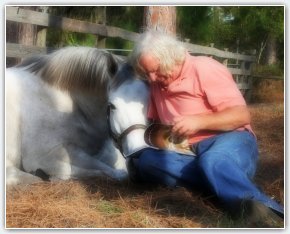 A normal canter stride is traditionally outside hind leg first. Then comes the diagonal sequence, inside hind leg and outside foreleg, which is followed by the support of the inside foreleg and up into the fly period. Better horses add a second fly period during the diagonal sequence, between the impact of the inside hind leg and ground contact of the outside foreleg. There are even exceptional horses which add a third fly period between support of the outside foreleg and alighting of the inside foreleg. He was thinking, how could we educate a horse to develop a second fly period during the diagonal sequence? The fact is that if such education was possible, racehorses could go faster. He developed in his mind a working hypothesis where it would be possible to create the phenomenon. But he dismissed the thought thinking that while possible such education would require too much time and knowledge. The racing industry is about quick money.
A normal canter stride is traditionally outside hind leg first. Then comes the diagonal sequence, inside hind leg and outside foreleg, which is followed by the support of the inside foreleg and up into the fly period. Better horses add a second fly period during the diagonal sequence, between the impact of the inside hind leg and ground contact of the outside foreleg. There are even exceptional horses which add a third fly period between support of the outside foreleg and alighting of the inside foreleg. He was thinking, how could we educate a horse to develop a second fly period during the diagonal sequence? The fact is that if such education was possible, racehorses could go faster. He developed in his mind a working hypothesis where it would be possible to create the phenomenon. But he dismissed the thought thinking that while possible such education would require too much time and knowledge. The racing industry is about quick money.
I started to realize the extent of his work. Scientific studies do not come as formulas ready to be applied. The practical application of advanced research studies is a science in itself. Even if only one third of scientific findings are applied the extent of the knowledge is a scaffold upon which the assemblage is based. I remember one of the scientific studies that he was reading while preparing for the first Immersion Program. The study was explaining how living organisms are constructed from tiers of systems within a system within a system. A limb is composed of bones, muscles, blood vessels, nerves, that in turn are constructed from muscle fibers, vascular endotheliums, connective tissues, which are composed of groups of living cells and their associated extracellular matrix. These extracellular matricies are macrocellular complexes that function as scaffolds for cell anchorage. One may say, I don’t need to know all that to ride a horse. Maybe not but one needs to understand that down to macrocellular level, performances and soundness relies on the proper coordination of all these systems. “Mechanical stresses can directly alter many cellular processes including, signal transduction, gene expression, growth, differentiation, and survival.” (1)
He summarizes quite well the problem referring to the concept of ease. He often states, If the horse is properly coordinated for the effort, the performance is effortless, starting with the gaits. If the rider struggles while sitting the horse’s trot, the horse is not properly coordinated for the trot. The horse is controlling balance using the braking phase of the front legs instead of their upward propulsive activity. I experienced this phenomenon yesterday. He was away for four days and my exuberance became out of control, I rolled frantically hurting my spine in the cranial thoracic area. It was a little uncomfortable but I did not realize how much I overdid until he rode me. His weight on my back awakened the muscular pain and when he asked me to trot for the warm up, I tried to use the effect of my nuchal ligament I lowered the neck pushing on the bit. Doing so, my nuchal ligament exerted a pull on the dorsal spines of my whither. This creates a lift of the whither area but also a rotation that is shifting the weight over the forelegs. I was too heavy on the forehand and when I went into the trot, I controlled my balance braking with the forelegs instead of propelling my body upward. It was quite uncomfortable. He halted me immediately realizing that I had a muscular issue. The rest of the training session became a physical therapy session designed to release the tension of my back muscles. It took a little more than 30 minutes at the walk but he worked my body until the muscle spasm vanished. We went then for another 30 minute walk outside.
He never let me trot heavy on the forehand and leaning on the bit, so I forgot how uncomfortable the trot can be when I am not properly coordinated for the effort. I feel great since. I had a comfortable night in my thick layer of shavings and today I was capable to further the coordination of my back muscles. Maybe I need to explain to you how this technique works from my perspective.
First of all, he never disturbs my back muscles shifting his body weight back to front or front to back. I do appreciate his stability. When the rider shifts his or her body weight back to front or front to back, the rider movements disturb our vertebral column mechanism. 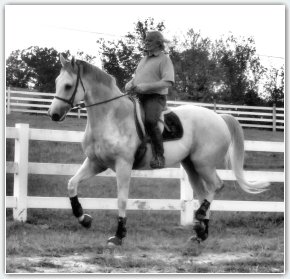 We then have great difficulties to properly coordinate the action of our back muscles which are situated in mirror image directions. Our capacity to resist gravity and therefore achieve balance control demands precise coordination of these muscles down to the fascicles that compose these muscles.
We then have great difficulties to properly coordinate the action of our back muscles which are situated in mirror image directions. Our capacity to resist gravity and therefore achieve balance control demands precise coordination of these muscles down to the fascicles that compose these muscles.
The second point is that when we are working at the walk or the trot or at the canter, his vertebral column barely moves. I do appreciate the moderated range of motion of his vertebral column because his movements are in harmony with my range of motion. Especially in the dorso-ventral direction, my vertebral column does have a very limited range of motion. He seems to have understood the phenomenon since his vertebral column moves within the same range of motion as mine. Basically, we are dancing the same subtle and discreet dance.
Then, he asks me to refine my straightness. I mean more straight than straight. A better description would be that he asks me to move within the limits of a very narrow corridor. This demands a very sophisticated body control. At the walk as well as at the trot, our vertebral column executes alternative lateral bending which are synchronized with the legs actions. In fact, our limbs are creating lateral bending of our spine and our spine is controlling and even resisting this lateral flexion in order to convert the thrust generated by the hind legs into forward movement. The faster we go the more we need to reduce those lateral flexions. Any lateral flexion is always coupled with a movement of transversal rotation, which occurs in the first half of our thoracic vertebrae. Transversal rotation induces longitudinal flexion and this is how it works. He is asking me to move so straight that I have to reduce the amplitude of my vertebral column’s lateral bending. The most efficient way for me to do that is to increase the longitudinal flexion of my spine. You have to understand that I am here describing what I am doing in terms of kinematics, which is the geometry of movements, when in fact I am working at a dynamic level. I am controlling, redirecting and modifying forces. The problem is that it is difficult to describe forces with words. When I say longitudinal flexion of my spine, naïve equitation thinks about a vertebral column becoming round like an arc. In fact, the geometry of my vertebral column barely changes. What I am doing is converting the thrust that I produce with my hind legs into horizontal forces, which are basically forward movement, and vertical forces that are allowing greater balance control.
I did not immediately figure this advanced way to coordinate my vertebral column mechanism. I first responded through natural reflexes. I rushed forward, I leaned on the bit, I moved my shoulders sideways, I shifted my croup to the right or to the left. He quietly asked me the same question; can you move straight, slowly, maintaining some activity of the hind legs without leaning on the bit. In fact he was using my errors to provide me more accurate insights. He helped me by guiding my brain toward the most efficient coordination of my vertebral column mechanism. Every time I feel simultaneously great control and great ease, he rewarded me. I already knew that I was good because it was effortless for me. His reward was simply reinforcing a feeling that I already liked. I am glad that he did not rush me forward. It would have been very difficult for me to concentrate and explore my own body beyond the limits of my natural reflexes if I had to deal with very strong activity of my hind legs. However, he is now asking me to maintain such advance control while increasing the propulsive activity of my hind and front legs.
In fact today, it was a moment where I was feeling such an easy control of my balance and power than I wanted to pick up the trot and show him how close I was to the piaff. 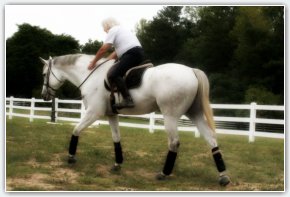 Instead he asked me for a square halt. He patted me and let me walk on long reins. His thought was then, You know, during this last coordination that you put together before we stopped, you were much closer to the piaff than you were when you were shaking your legs in cadence.
Instead he asked me for a square halt. He patted me and let me walk on long reins. His thought was then, You know, during this last coordination that you put together before we stopped, you were much closer to the piaff than you were when you were shaking your legs in cadence.
Chazot
Edited by Susan Hopf
Tweet
References
(1) (Tensegrity and mechanoregulation: from skeleton to cytoskeleton, Christopher S. Chen and Donald E. Ingber, Osteoarthritis and Cartilage, 1999. &, 81-94)
-94)



 twitter
twitter facebook
facebook delicious
delicious digg
digg google
google stumbleupon
stumbleupon yahoo
yahoo linkedin
linkedin blogger
blogger